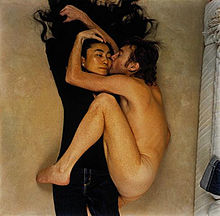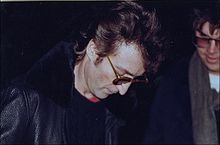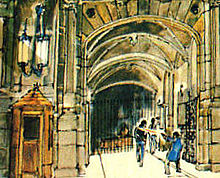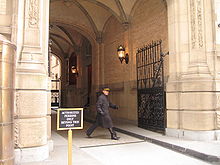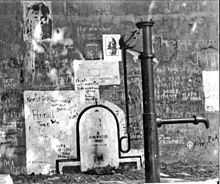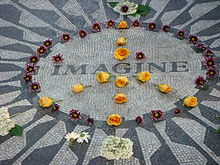- Death of John Lennon
-
Coordinates: 40°46′35″N 73°58′34″W / 40.776436°N 73.976006°W
Murder of John Lennon 
The Dakota, location of the killingLocation The Dakota, Manhattan, New York Date 10:50 pm, 8 December 1980 (approx. time) Target John Lennon Weapon(s) Charter Arms .38 Special revolver[1] Death(s) 1 Perpetrator Mark David Chapman John Lennon was an English musician who gained worldwide fame as one of the founders of The Beatles, for his subsequent solo career, and for his political activism and pacifism. He was shot by Mark David Chapman at the entrance of the building where he lived, The Dakota, in New York City, on Monday, 8 December 1980; Lennon had just returned from Record Plant Studio with his wife, Yoko Ono.
Lennon was pronounced dead on arrival at St. Luke's-Roosevelt Hospital Center, where it was stated that nobody could have lived for more than a few minutes after sustaining such injuries. Shortly after local news stations reported Lennon's death, crowds gathered at Roosevelt Hospital and in front of The Dakota. He was cremated on 10 December 1980, at the Ferncliff Cemetery in Hartsdale, New York; the ashes were given to Ono, who chose not to hold a funeral for him. The first report of his death to a national audience was announced by Howard Cosell, on ABC's Monday Night Football.
Contents
Events preceding his death
8 December 1980
On the afternoon of 8 December 1980, photographer Annie Leibovitz went to Ono and Lennon's apartment at 2:00pm to do a photo shoot for Rolling Stone magazine.[2] Leibovitz promised Lennon that a photo with Ono would make the front cover of the magazine, but initially tried to get a picture with just Lennon alone.[3] Leibovitz recalled that "nobody wanted [Ono] on the cover".[4] Lennon then insisted that both he and his wife be on the cover, and after taking the pictures, Leibovitz left their apartment at 3:30pm.[2] After the photo shoot, Lennon gave what would be his last interview to a San Francisco DJ, Dave Sholin, for a music show on the RKO Radio Network.[5] At 5:00 pm, Lennon and Ono left their apartment to mix the song "Walking on Thin Ice"; an Ono song featuring Lennon on lead guitar, at the Record Plant Studio.[6]
Mark David Chapman
As Lennon and Ono walked to their limousine, they were approached by several people seeking autographs, among them, Chapman.[7] It was common for fans to wait outside the Dakota to meet Lennon and ask for his autograph.[8] Chapman, a 25-year-old security guard from Honolulu, Hawaii, had first come to New York to murder Lennon in October (before the release of Double Fantasy), but changed his mind and returned home.[9] Chapman silently handed Lennon a copy of Double Fantasy, and Lennon obliged with an autograph.[7] After signing the album, Lennon asked him, "Is this all you want?" Chapman smiled and nodded in agreement. Photographer and Lennon fan, Paul Goresh, took a photo of the encounter.[10] Chapman had been waiting for Lennon outside the Dakota since mid morning and had even approached the Lennons' young son Sean with the family nanny Helen Seaman as they returned to the Dakota in the afternoon, allegedly, according to Chapman himself, briefly touching the boy's hand as he was introduced to the waiting 'fan' himself.
The Lennons spent several hours at the Record Plant studio before returning to the Dakota at approximately 10:50 pm.[11] Lennon had decided against dining out so he could be home in time to say goodnight to his five-year-old son, Sean, before going to the Stage Deli restaurant with Ono.[11] Lennon liked to oblige any fans who had been waiting for long periods of time to meet him with autographs or pictures, once saying during an interview with BBC Radio's Andy Peebles,[12] on 5 December 1980: "People come and ask for autographs, or say 'Hi', but they don't bug you".[2] The Lennons exited their limousine on 72nd Street instead of driving into the more secure courtyard of the Dakota.[13]
Mark David Chapman had become a born-again Christian in 1970,[14] and was incensed by Lennon's "bigger than Jesus" remark, calling it blasphemy. He later stated he was further enraged by "God", and "Imagine"—even singing the latter with the altered lyric: "Imagine John Lennon dead."[15]
Murder
Jose Perdomo, the Dakota's doorman, and a nearby cab driver saw Chapman standing in the shadows by the archway.[16] Ono walked ahead of Lennon and into the reception area. As Lennon passed by, he looked at Chapman briefly and continued on his way. Within seconds, Chapman took aim directly at the center of Lennon's back and fired five hollow-point bullets at him from a Charter Arms .38 Special revolver in rapid succession.[1] Based on statements made that night by NYPD Chief of Detectives James Sullivan, numerous radio, television, and newspaper reports claimed at the time that, before firing, Chapman called out "Mr. Lennon" and dropped into a "combat stance".[17][18][19] But court hearings and witness interviews do not include either "Mr. Lennon" or the "combat stance" description. Chapman has said he did not remember calling out Lennon's name before he shot him.[20][21][22] The first bullet missed, passing over Lennon's head and hitting a window of the Dakota building. However, two of the next bullets struck Lennon in the left side of his back, and two more penetrated his left shoulder. Three of the four bullets passed completely through and exited the front of Lennon's body, resulting in a total of seven gunshot wounds. While all four shots inflicted severe gunshot wounds, two of the wounds were fatal which were to his left lung and the left subclavian artery, near where it branches off of the aorta. Lennon, bleeding profusely from his external wounds and also from the mouth, staggered up five steps to the security/reception area and fell to the floor, scattering the arm-full of cassettes he had been carrying. Concierge Jay Hastings first started to make a tourniquet; but upon ripping open Lennon's blood-stained shirt and realizing the severity of his multiple injuries, covered Lennon's chest with his uniform's jacket, removed his blood-covered glasses, and summoned the police.[11]
Outside, doorman Perdomo shook the gun out of Chapman's hand then kicked it across the sidewalk.[16] Chapman then removed his coat and hat in preparation for the police arrival to show he was not carrying any concealed weapons and sat down on the sidewalk. Doorman Perdomo shouted at Chapman, "Do you know what you've done?", to which Chapman calmly replied, "Yes, I just shot John Lennon." The first policemen to arrive were Steve Spiro and Peter Cullen, who were at 72nd Street and Broadway when they heard a report of shots fired at the Dakota. The officers arrived around two minutes later and found Chapman sitting "very calmly" on the sidewalk. They reported that Chapman had dropped the revolver to the ground, and was holding a paperback book, J.D. Salinger's The Catcher in the Rye.[23] Chapman had scribbled a message on the book's inside front cover: "To Holden Caulfield. From Holden Caulfield. This is my statement." He would later claim that his life mirrored that of Holden Caulfield, the protagonist of the book.
The second team, Officers Bill Gamble and James Moran, arrived a few minutes later. They immediately carried Lennon into their squad car and rushed him to Roosevelt Hospital. Officer Moran said they placed Lennon on the back seat.[24] Moran asked, "Do you know who you are?" There are conflicting accounts on what happened next. In one account, Lennon nodded slightly and tried to speak, but could only manage to make a gurgling sound, and lost consciousness shortly thereafter.[25]
Dr. Stephan Lynn received Lennon in the emergency room at Roosevelt Hospital. When Lennon arrived, he had no pulse and was not breathing. Dr. Lynn and two other doctors worked for nearly 20 minutes, opening Lennon's chest and attempting manual heart massage to restore circulation, but the damage to the blood vessels around the heart was too great.[26] Lennon was pronounced dead on arrival in the emergency room at the Roosevelt Hospital at 11:15 pm by Dr Lynn,[27] but the time of 11:07 pm has also been reported.[28] The cause of death was reported as hypovolemic shock, caused by the loss of more than 80% of blood volume. Dr. Elliott M. Gross, the Chief Medical Examiner who examined Lennon's body, said in his pathology report that no one could have lived more than a few minutes with such multiple bullet injuries.[citation needed] As Lennon was shot four times with hollow-point bullets, which expand upon entering the target and severely disrupt more tissue as they travel through the target, Lennon's affected organs were virtually destroyed upon impact. Ono, sobbing "Oh no, no, no, no... tell me it's not true," was taken to Roosevelt Hospital and led away in shock after she learned that her husband was dead.[29]
Monday Night Football
Ono asked the hospital not to report that Lennon was dead until she had informed their son, who was at home at the time. Ono said she did not want her son to learn that his father was dead from the television.[29]
Although the hospital had not confirmed the shooting nor Lennon's condition, word was relayed to ABC News by Alan Weiss, a reporter from WABC-TV reporter who had been taken to Roosevelt Hospital earlier that evening after suffering injuries from a motorcycle accident. Weiss was in the emergency room when Lennon was rushed in. He called in the news to the station's assignment editor, Neil Goldstein, who relayed it to ABC News division and president Roone Arledge.
Arledge was also president of ABC Sports and the executive producer of Monday Night Football. That night's contest between the Miami Dolphins and New England Patriots was still going on when Arledge received the news, and Arledge suggested to broadcast team Howard Cosell and Frank Gifford they announce Lennon's death on air. Cosell expressed apprehension, but he was eventually convinced to make the announcement by Gifford. When the news was relayed to them the Patriots were driving to potentially score the game-winning points as the score was tied; the following transcript of what was said begins with thirty seconds remaining in the game as Cosell sets the stage for his announcement:[30]
“ Cosell: ...but (the game)'s suddenly been placed in total perspective for us; I'll finish this, they're in the hurry-up offense.
Gifford: Third down, four. Foreman...it'll be fourth down. Cavanaugh will let it run down for one final attempt, he'll let the seconds tick off to give Miami no opportunity whatsoever. (whistle blows) Timeout is called with three seconds remaining, John Smith is on the line. And I don't care what's on the line, Howard- you have got to say what we know in the booth.
Cosell: Yes, we have to say it. Remember this is just a football game, no matter who wins or loses. An unspeakable tragedy confirmed to us by ABC News in New York City: John Lennon, outside of his apartment building on the West Side of New York City. The most famous perhaps, of all of The Beatles, shot twice in the back, rushed to Roosevelt Hospital, dead on arrival. Hard to go back to the game after that news flash, which, in duty bound, we have to take.[31]” Sean was not watching TV that night, so Ono was able to break the news to him herself. The following day, Ono issued a statement: "There is no funeral for John. John loved and prayed for the human race. Please do the same for him. Love, Yoko and Sean."[32]
Aftermath
Lennon's murder—considered by some to be an assassination due to his high profile—triggered an outpouring of grief around the world on an unprecedented scale.[33] Sales of his music—both with the Beatles and as a solo artist—soared in the months following the murder. Lennon's remains were cremated at Ferncliff Cemetery in Westchester; no funeral was held.[34][35] Ono sent word to the chanting crowd outside the Dakota that their singing had kept her awake; she asked that they re-convene in Central Park the following Sunday for ten minutes of silent prayer.[36] On 14 December 1980, millions of people around the world responded to Ono's request to pause for ten minutes of silence to remember Lennon.[37] Thirty thousand gathered in Liverpool, and the largest group—over 225,000—converged on New York's Central Park, close to the scene of the shooting.[37] At least two Beatles fans committed suicide after the murder, leading Ono to make a public appeal asking mourners not to give in to despair.[38] Ono released a solo album, Season of Glass, in 1981. The cover of the album is a photograph of Lennon's blood-spattered glasses. A 1997 re-release of the album included "Walking on Thin Ice", the song the Lennons had mixed at the Record Plant less than an hour before he was murdered.[29] Chapman pleaded guilty to Lennon's murder in June 1981,[39] against the advice of his lawyers,[40] who wanted to file an insanity plea.[41][42] He received a life sentence, but under the terms of his guilty plea became eligible for parole after serving 20 years.[43] Chapman has been denied parole at hearings every two years since 2000 and remains an inmate at Attica State Prison.[44][45] Because of the Nixon administration's FBI/CIA surveillance to spy and efforts to deport Lennon in the 1970s,[46] there are those who believe the murder might have had political motivation.[47][48]
Memorials and tributes
Annie Leibovitz's photo of a naked Lennon embracing his wife, taken on the day of the murder, was the cover of Rolling Stone's 22 January 1981 issue, most of which was dedicated to articles, letters and photographs commemorating Lennon's life and death.[49] In 2005 the American Society of Magazine Editors ranked it as the top magazine cover of the last 40 years.[50] George Harrison released a tribute song, "All Those Years Ago", which featured Ringo Starr and Paul McCartney in 1981. McCartney released his own tribute, "Here Today" on his 1982 album, Tug of War. Elton John, who had recorded the number-one hit "Whatever Gets You thru the Night" with Lennon, teamed up with his lyricist, Bernie Taupin and recorded a tribute to Lennon, entitled "Empty Garden (Hey Hey Johnny)." It appeared on his 1982 album, Jump Up!, and peaked at #13 on the US Singles Chart that year.[51] When he performed the song at a sold-out concert in Madison Square Garden in August 1982, he was joined on stage by Ono and Sean.[52]
In 1985, New York City dedicated an area of Central Park directly across from The Dakota as Strawberry Fields, where Lennon had frequently walked. In a symbolic show of unity, countries from around the world donated trees and the city of Naples, Italy, donated the Imagine mosaic centerpiece.[53]
Lennon was honoured with a Grammy Lifetime Achievement Award in 1991.[54] In 1994, the breakaway autonomous republic of Georgia, Republic of Abkhazia, issued two postage stamps featuring the faces of Lennon and Groucho Marx, rather than portraits of Vladimir Lenin and Karl Marx, spoofing Abkhazia's Communist past.[55] On 8 December 2000, Cuba's President Fidel Castro unveiled a bronze statue of Lennon in a park in Havana.[56] In 2000, the John Lennon Museum was opened at the Saitama Super Arena in the city of Saitama, Japan (but closed on 30 September 2010),[57] and Liverpool renamed its airport to Liverpool John Lennon Airport, adopting the motto, "Above us only sky", in 2002.[58] The minor planet 4147 Lennon, discovered 12 January 1983 by B. A. Skiff at the Anderson Mesa Station of the Lowell Observatory, was named in memory of Lennon.[59] On 9 December 2006, in the city of Puebla, Mexico, a plaque was revealed, honouring Lennon's contribution to music, culture and peace.[60] On 9 October 2007, Ono dedicated a new memorial called the Imagine Peace Tower, located on the island of Viðey, off the coast of Iceland. Each year, between 9 October and 8 December, it projects a vertical beam of light high into the sky in Lennon's memory.[61]
Every 8 December a memorial ceremony is held in front of the Capitol Records building on Vine Street in Hollywood, California. People also light candles in front of Lennon's Hollywood Walk of Fame star, outside the Capitol Building.[62] From 28 to 30 September 2007, Durness held the John Lennon Northern Lights Festival which was attended by Julia Baird (Lennon's half-sister), who read from Lennon's writings and her own books, and Stanley Parkes, Lennon's Scottish cousin.[63] Parkes said, "Me and Julia [Baird] are going to be going to the old family croft to tell stories". Musicians, painters and poets from across the UK performed at the festival.[63][64]
In 2009, the Rock and Roll Hall of Fame's New York City annexe hosted a special John Lennon exhibit, which included many mementoes and personal effects from Lennon's life, as well as the clothes he was wearing when he was murdered, still in the brown paper bag from Roosevelt Hospital.[65] Ono still places a lit candle in the window of Lennon's room in the Dakota on 8 December.[66]
On film
Two films depicting the murder of Lennon were released in close proximity of each other more than 25 years after the event. The first of the two, The Killing of John Lennon, was released on 7 December 2007. Directed by Andrew Piddington, the movie starred Jonas Ball as Mark David Chapman.[67] The second film was Chapter 27, released on 28 March 2008. Directed by J. P. Schaefer, the film starred Jared Leto as Mark David Chapman. Lennon was portrayed by actor Mark Lindsay Chapman.[68]
Notes
- ^ a b "Police Trace Tangled Path Leading To Lennon's Slaying at the Dakota". elvispelvis.com. http://elvispelvis.com/johnlennon.htm#NYT. Retrieved 20 December 2007.
- ^ a b c Badman 2001, p. 271.
- ^ "Hours After This Picture Was Taken John Lennon Was Dead". Guardian Unlimited. 12 August 2005. http://www.buzzle.com/editorials/12-8-2005-83469.asp. Retrieved 26 July 2007.
- ^ Lucas, Dean (2007). "Naked Lennon". Famous Pictures Magazine. http://www.famouspictures.org/mag/index.php?title=Naked_Lennon. Retrieved 26 July 2007.
- ^ Smith, Harry (8 December 2005). "John Lennon Remembered". CBS News. http://www.cbsnews.com/stories/2005/12/08/earlyshow/leisure/celebspot/main1107803.shtml. Retrieved 8 November 2008.
- ^ "The Last Days of Dead Celebrities". ABC, Inc.. http://abcnews.go.com/GMA/Books/Story?id=2165256&page=4. Retrieved 26 December 2007.
- ^ a b "Is That All You Want?". Courtroom Television Network. http://www.crimelibrary.com/terrorists_spies/assassins/chapman/7.html. Retrieved 4 May 2008.
- ^ Cocks, Jay (22 December 1980). "The Last Day In The Life". Time. http://www.time.com/time/magazine/article/0,9171,924600,00.html. Retrieved 23 October 2010.
- ^ "Descent Into Madness". People. 22 June 1981. http://www.people.com/people/archive/article/0,,20079581,00.html.
- ^ Buskin, Richard (3 July 2007). "John Lennon Encounters Mark David Chapman". Howstuffworks.com. http://people.howstuffworks.com/john-lennon52.htm. Retrieved 6 May 2008.
- ^ a b c Badman 2001, p. 272.
- ^ Badman 2001, p. 270.
- ^ Ledbetter, Les (9 December 1980). "John Lennon of Beatles Is Killed". New York Times.
- ^ Jones 1992, p. 115.
- ^ Jones 1992, p. 118.
- ^ a b "Do It, Do It, Do It!". Courtroom Television Network. http://www.crimelibrary.com/terrorists_spies/assassins/chapman/8.html. Retrieved 4 May 2008.
- ^ CBS Evening News television report, 9 December 1980.
- ^ ABC News Nightline television report early in the morning of 9 December 1980. The "Mr. Lennon" and "combat stance" statements were made several times.
- ^ "Police Trace Tangled Path Leading To Lennon's Slaying at the Dakota" by Paul L. Montgomery, The New York Times, 10 December 1980, pp. A1,B6 (unverified quotes attributed to NYPD Chief of Detectives James T. Sullivan and in turn to an unnamed witness)
- ^ "I don't recall saying, 'Mr Lennon'". Telegraph.co.uk (London). 21 August 2008. http://www.telegraph.co.uk/news/newstopics/celebritynews/2593371/John-Lennon-murder-Killer-Mark-David-Chapman-gives-new-details-of-shooting.html. Retrieved 21 August 2008.
- ^ "Transcript of 2008 parole hearing in which Chapman denies calling out "Mr Lennon"". News.google.com. http://news.google.com/newspapers?id=Q5USAAAAIBAJ&sjid=wvYDAAAAIBAJ&pg=6824,1469290&dq=john+lennon+murder+fan+suicides+costello&hl=en. Retrieved 23 October 2010.
- ^ "Transcript of 1981 competency hearing in which Chapman says he did not say anything to Lennon". Jfkmontreal.com. http://www.jfkmontreal.com/john_lennon/app_c_sentencinghearing.htm. Retrieved 23 October 2010.
- ^ Montgomery, Paul L. (9 February 1981). "Lennon Murder Suspect Preparing Insanity Defense". The New York Times. http://query.nytimes.com/gst/fullpage.html?sec=health&res=9E00E1D8133BF93AA35751C0A967948260. Retrieved 6 May 2008.
- ^ Edwards, David (3 December 2005). "Lennon’s Last Day". Daily Mirror. http://www.mirror.co.uk/news/tm_objectid=16442570&method=full&siteid=94762&headline=monday-8th-december-1980--lennon-s-last-day--name_page.html. Retrieved 4 May 2008.
- ^ "Lennon shot on way to see son". Thestar.com (Toronto). 10 June 2007. http://www.thestar.com/entertainment/article/223747. Retrieved 20 December 2007.
- ^ "Recalling the Night He Held Lennon's Still Heart", Corey Kilgannon, New York Times, 8 Dec. 2005
- ^ "John Lennon Death Certificate". JFKmontreal.com. 22 June 2004. http://www.jfkmontreal.com/john_lennon/Death_Cert.htm. Retrieved 6 December 2009.
- ^ Ingham 2006, p. 82.
- ^ a b c http://www.itv.com/presscentre/thedayjohnlennondied/week49/default.html
- ^ Ausiello, Jeff (2010-12-05). "Ex-Pats kicker forever linked to Lennon". ESPN.com. http://sports.espn.go.com/espn/otl/news/story?id=5880125. Retrieved 2010-12-06.
- ^ Monkovic, Toni (2010-12-06). "Behind Cosell’s Announcement of Lennon’s Death". The New York Times. http://fifthdown.blogs.nytimes.com/2010/12/06/behind-cosells-announcement-of-lennons-death/. Retrieved 2010-12-06.
- ^ "Retro: Lennon shot dead". Yorkshire Evening Post. 9 December 2010. http://www.yorkshireeveningpost.co.uk/news/latest-news/retro_lennon_shot_dead_1_3016017. Retrieved 29 April 2011.
- ^ Buskin, Richard (1 December 1997). The Complete Idiot's Guide to Beatles. Alpha. p. 185. ISBN 0028621301.
- ^ "List of celebrities cremated or interred at Ferncliff Cemetery". Ferncliffcemetery.com. 26 February 1902. http://www.ferncliffcemetery.com/celeb_2.htm. Retrieved 23 October 2010.
- ^ "Lennon slaying linked to quote". Milwaukee Sentinel. 11 December 1980. http://news.google.com/newspapers?id=FdQVAAAAIBAJ&sjid=EhIEAAAAIBAJ&pg=6527,2565851&dq=john+lennon+cremated&hl=en.
- ^ Gentile, Fiorella Dorotea. "The Central Park Vigil, New York, 14 December 1980". Thou Art. http://www.johnlennon.it/english.htm. Retrieved 3 May 2008.
- ^ a b Clyde Haberman, "Silent Tribute to Lennon's Memory is Observed Throughout the World," The New York Times, 15 December 1980 pA1
- ^ ""Suicides push Lennon's wife to caution his fans", ''The Bulletin'' (Bend, Deschuets County, Oregon), Dec. 12, 1980". News.google.com. http://news.google.com/newspapers?id=Q5USAAAAIBAJ&sjid=wvYDAAAAIBAJ&pg=6824,1469290&dq=john+lennon+murder+fan+suicides+costello&hl=en. Retrieved 23 October 2010.
- ^ "Divine Justice". Time. 6 July 1981. http://www.time.com/time/magazine/article/0,9171,922589,00.html.
- ^ ""A Matched Pair of Gunmen", TIME Magazine, Sept. 7, 1981". Time.com. 7 September 1981. http://www.time.com/time/magazine/article/0,9171,924795,00.html. Retrieved 23 October 2010.
- ^ "John Lennon's Killer: The Nowhere Man", ''New York Magazine'', 22 June 1981. Books.google.com. 22 June 1981. http://books.google.com/?id=BeYCAAAAMBAJ&pg=PA30&lpg=PA30&dq=mark+david+chapman+jonathan+marks#. Retrieved 23 October 2010.
- ^ Montgomery, Paul L. (9 February 1981). "Lennon Murder Suspect Preparing Insanity Defense". New York Times. http://www.nytimes.com/1981/02/09/nyregion/lennon-murder-suspect-preparing-insanity-defense.html. Retrieved 23 October 2010.
- ^ http://today.msnbc.msn.com/id/39037888/ns/today-entertainment/
- ^ "Transcript of 2008 Chapman parole hearing". Scribd.com. 12 August 2008. http://www.scribd.com/doc/4895151/Mark-David-Chapman-Parole-Transcript. Retrieved 23 October 2010.
- ^ "Transcript of 2010 Chapman parole hearing". Scribd.com. 7 September 2010. http://www.scribd.com/doc/37565854/Mark-David-Chapman-Parole-Hearing-2010. Retrieved 8 December 2010.
- ^ Cohen, Adam (21 September 2006). "While Nixon Campaigned, the F.B.I. Watched John Lennon". The New York Times. http://www.nytimes.com/2006/09/21/opinion/21thu4.html.
- ^ Whitehead, John W. (2 December 2008). "Who Killed John Lennon?". Huffington Post. http://www.huffingtonpost.com/john-w-whitehead/who-killed-john-lennon_b_147351.html. Retrieved 2 May 2011.
- ^ Fenton Bresler in Who Killed John Lennon, St. Martin's Press (November 1990)
- ^ John Lennon & Yoko Ono-RS 335 (22 January 1981)
- ^ "Lennon Leads List of Top Magazine Covers". MSNBC. 17 October 2005. http://www.msnbc.msn.com/id/9729637/. Retrieved 23 October 2010.
- ^ http://www.billboard.com/charts/r-b-hip-hop-songs?chartDate=1981-10-03#/song/elton-john/empty-garden-hey-hey-johnny/1102310
- ^ "John Lennon". songfacts.com. http://www.songfacts.com/detail.php?id=1668. Retrieved 12 May 2009.
- ^ "Imagine Mosaic: W72 At Strawberry Fields". Central Park 2000. http://www.centralpark2000.com/database/imagine_mosaic.html. Retrieved 2 May 2011.
- ^ http://open-site.org/Arts/Music/Awards/GRAMMY/Lifetime_Achievement_Award
- ^ Robinson, Ben. "March Marx Magic". Ben Robinson. http://www.illusiongenius.com/3-2001.html. Retrieved 6 May 2008.
- ^ "Once-shunned Lennon now feted in communist Cuba". CNN. 8 December 2000. http://archives.cnn.com/2000/WORLD/americas/12/08/lennon.cuba.reut/. Retrieved 6 May 2008.
- ^ Winter, Michael (30 September 2010). "First John Lennon museum closes after 10 years". USA Today. http://content.usatoday.com/communities/ondeadline/post/2010/09/first-john-lennon-museum-closes-in-japan-after-10-years/1.
- ^ "Background Information". Liverpool John Lennon Airport. Archived from the original on 18 May 2006. http://web.archive.org/web/20060518123817/http://www.liverpoolairport.com/page.php?p=5. Retrieved 3 May 2008.
- ^ "Lennon's planet". cfa.harvard.edu. http://www.cfa.harvard.edu/iau/special/rocknroll/0004147.html. Retrieved 20 December 2007.
- ^ "La Jornada de Oriente en Internet :: Puebla". Lajornadadeoriente.com.mx. http://www.lajornadadeoriente.com.mx/2006/12/08/puebla/cul113.php. Retrieved 23 October 2010.
- ^ "The Imagine Peace Tower". Imagine Peace. Archived from the original on 17 October 2007. http://web.archive.org/web/20071017035334/http://www.imaginepeace.com/tower.html. Retrieved 3 May 2008.
- ^ Wayne, Gary. "Capitol Records Building". http://www.seeing-stars.com/Landmarks/CapitolRecords.shtml. Retrieved 8 May 2008.
- ^ a b "John Lennon Northern Lights Festival in Durness". Scotland homepage. http://www.scotland.com/blog/john-lennon-northern-lights-festival-in-durness. Retrieved 25 December 2007.
- ^ Ross, John (19 May 2007). "Village strikes a chord with Lennon festival". The Scotsman. http://thescotsman.scotsman.com/scotland/Village-strikes-a-chord-with.3287730.jp. Retrieved 25 December 2007.
- ^ Carucci, John (12 May 2009). "Yoko Ono displays John Lennon's bloodied clothes". Huffington Post. http://www.huffingtonpost.com/2009/05/12/yoko-ono-displays-john-le_n_202702.html.
- ^ Lennon Fans Remember From the New York Daily News and reprinted in the Palm Beach Sun-Sentinel, 12 December 2005, page found 3 March 2010.
- ^ Smith, Kyle (4 January 2008). "The Killing of John Lennon". Rotten Tomatoes. http://www.rottentomatoes.com/m/the-killing-of-john-lennon/. Retrieved 7 August 2011.
- ^ Emerson, Jim (25 April 2008). "Chapter 27". Rotten Tomatoes. http://www.rottentomatoes.com/m/1193377-chapter_27/. Retrieved 7 August 2011.
References
- Jones, Jack (1992). Let Me Take You Down: Inside the Mind of Mark David Chapman, the Man Who Killed John. Villard Books. ISBN 978-0812991703.
Books and articles
- Badman, Keith (2001). The Beatles After the Breakup 1970-2000: A day-by-day diary. Omnibus Press. ISBN 978-0711983076.
- Seaman, Fred (1991). The Last Days of John Lennon. Birch Lane Press. ISBN 978-1559720847.
- Bresler, Fenton (1990). Who Killed John Lennon. St. Martin's Press. ISBN 978-0312923679.
- Cocks, Jay (22 December 1980). "The Last Day in the Life". Time.
- David Rosenthal et al., "The Death and Life of John Lennon". New York, 22 December 1980.
- Tom Mathews et al., "Death of a Beatle." Newsweek, 22 December 1980.
External links
- Tom Brook BBC
- "Lennon’s death lingers for those who were there", MSNBC.com, 8 Dec. 2005
- "Witnesses From the Night Lennon Was Shot", FOX News, 7 Dec. 2005
- The Grounded Walrus Blog writer extensively covers details, including speculations of conspiracy, on Lennon's death, beginning 18 September 2009.
- CRIME FILE - Famous crime: Mark Chapman: The Assassination of John Lennon, History Channel, Crime Investigation Network
John Lennon Studio albums With Yoko Ono Unfinished Music No.1: Two Virgins · Unfinished Music No.2: Life with the Lions · Wedding Album · Some Time in New York City · Double Fantasy · Milk and Honey · Double Fantasy Stripped DownLive albums Compilations Shaved Fish · The John Lennon Collection · Menlove Ave. · Lennon Legend: The Very Best of John Lennon · Wonsaponatime · Instant Karma: All-Time Greatest Hits · Acoustic · Peace, Love & Truth · Working Class Hero: The Definitive Lennon · Power to the People: The HitsSoundtracks Imagine: John Lennon · The U.S. vs. John LennonBox sets Books Films How I Won the War (1967) · Two Virgins (1968) · No. 5 (1968) · Honeymoon (1969) · Freedom (1970) · Fly (1970) · Legs (1970) · Apotheosis (1970) · Erection (1971) · Imagine (1972) · Dynamite Chicken (1972) · Oh! Calcutta! (1972) · John and Yoko: A Love Story (1985) · Imagine: John Lennon (1988) · In His Life: The John Lennon Story (2000) · The U.S. vs. John Lennon (2006) · The Killing of John Lennon (2006) · Chapter 27 (2007) · I Met the Walrus (2007) · Nowhere Boy (2009) · Lennon Naked (2010)Family Alfred Lennon (father) · Julia Lennon (mother) · Mimi Smith (aunt) · George Smith (uncle) · Julia Baird (half-sister) · Cynthia Lennon (1st wife) · Julian Lennon (1st son) · Yoko Ono (2nd wife) · Sean Lennon (2nd son)Related PeopleThe Beatles · Lennon–McCartney · May Pang · Harry Nilsson · John Sinclair · Rosaura Lopez · Frederic Seaman · Plastic Ono Band · Mark David ChapmanMediaThe Lost Lennon Tapes · Come Together: A Night for John Lennon's Words and Music (concert) · ROOTS: John Lennon Sings The Great Rock & Roll Hits · Pussy Cats · Working Class Hero: A Tribute to John Lennon · Instant Karma: The Amnesty International Campaign to Save Darfur · The 30th Annual John Lennon Tribute: Live from the Beacon Theatre, NYC · A Toot and a Snore in '74 · Lennon (musical) · Lennon Legend: The Very Best of John Lennon (DVD) · The Rolling Stones Rock and Roll CircusArticlesAssassination · 251 Menlove Avenue · Bagism · Liverpool John Lennon Airport · More popular than Jesus · John Lennon Museum · The Immigrant · Empty Garden (Hey Hey Johnny) · Songwriting ContestConspiracy theories Core topics Psychology Deaths - Eric V of Denmark (1286)
- Geoffrey Chaucer (1400)
- Princes in the Tower (1483)
- Abraham Lincoln (1865)
- Franz Ferdinand (1914)
- Phar Lap (1932)
- Sergey Kirov (1934)
- Joseph Stalin (1953)
- Dag Hammarskjöld (1961)
- Patrice Lumumba (1961)
- Marilyn Monroe (1962)
- John F. Kennedy (1963)
- Malcolm X (1965)
- Robert F. Kennedy (1968)
- Martin Luther King Jr. (1968)
- Juscelino Kubitschek (1976)
- Pope John Paul I (1978)
- John Lennon (1980)
- Olof Palme (1986)
- Zia-ul-Haq (1988)
- Kurt Cobain (1994)
- Yitzhak Rabin (1995)
- Diana, Princess of Wales (1997)
- David Kelly (2003)
- Alexander Litvinenko (2006)
- Benazir Bhutto (2007)
- Michael Jackson (2009)
- Osama bin Laden (2011)
- Sinking of the USS Maine (1898)
- Sinking of the RMS Lusitania (1915)
- Reichstag fire (1933)
- Pearl Harbor
- Operation Gladio
- USS Liberty incident (1967)
- KAL 007 (1983)
- Mozambican presidential jet (1986)
- Pan Am Flight 103 (1988)
- Oklahoma City bombing (1995)
- Port Arthur massacre (1996)
- TWA Flight 800 (1996)
- Russian apartment bombings (1999)
- 9/11 attacks (Advance knowledge
- WTC collapse)
- Madrid train bombing (2004)
- London bombings (2005)
Other- Titanic alternative theories (1912)
- Cairo Fire (1952)
- Jonestown (1978)
- Satanic ritual abuse (Blood libel)
- Sinking of MS Estonia (1994)
- Columbine High School massacre (1999)
16th/17th-century
EnglandNew World Order UFO GeneralIncidentsU.S. Government - Apollo Moon landings
- Barack Obama's citizenship / religion
- CIA-Kennedy assassination link
- CIA-Osama bin Laden link
- Dulles' Plan
- HAARP
- Montauk Project
- October surprise (1980)
- Philadelphia Experiment (1943)
- Sovereign citizen / Redemption movement
- Vast right-wing conspiracy
- Vietnam War POW / MIA issue
- Waco Siege (1993)
- Dual EC DRBG
Health, energy and
environmentOther - 2012 phenomenon (Nibiru collision)
- Bible conspiracy theory
- Dominionism
- Gay / Lavender Mafia
- Greater Bangladesh
- Homintern
- Overthrow of Sukarno (1966)
- Paul McCartney's death (1966)
- Scottish mafia
- Soviet space program (1957–1966)
- Elvis Presley's survival (1977)
- Vela Incident (1979)
- New Coke (1985)
- George Soros
- Red mercury
- Mexican Reconquista
Proven true - Dreyfus affair (1894)
- Affaire Des Fiches (1904–1905)
- Gleiwitz incident (1939)
- Operation Ajax (1953)
- Lavon Affair (1954)
- Operation Northwoods (1962)
- Watergate (1972)
- Project MKULTRA (1975)
- COINTELPRO
- CIA drug trafficking
- Operation INFEKTION
- Operation Mockingbird
- Iran-Contra affair (1986)
- Swiss secret files scandal (1989)
- Operation Opera Orientalis
- Propaganda Due
- Niger uranium forgeries (2001)
Categories:- John Lennon
- 1980 in music
- 1980 in New York
- 1980 murders in the United States
- Deaths by person
- Crime in New York City
Wikimedia Foundation. 2010.

